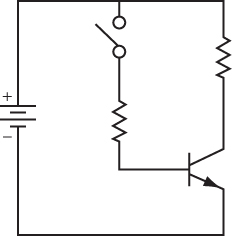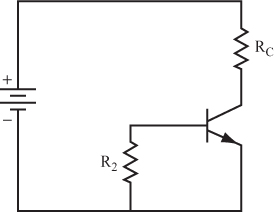Turning Off the Transistor
11 Up to now, you have concentrated on turning the transistor ON, thus making it act like a closed mechanical switch. Now you focus on turning it OFF, thus making it act like an open mechanical switch. If the transistor is OFF, no current flows through the load (that is, no collector current flows).
12 You can be sure that there is no base current in the circuit shown in Figure 4.6 by opening the mechanical switch.
To ensure that the transistor remains OFF when the base is not connected to the supply voltage, you add a resistor (labeled R2 in Figure 4.7) to the circuit. The base of the transistor connects to ground or 0 volts through this resistor. Therefore, no base current can possibly flow.
Get Complete Electronics Self-Teaching Guide with Projects now with the O’Reilly learning platform.
O’Reilly members experience books, live events, courses curated by job role, and more from O’Reilly and nearly 200 top publishers.



